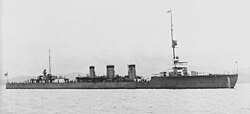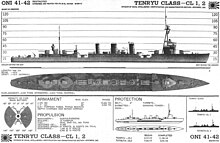Tenryū class
|
The Tatsuta in August 1919.
|
||||||||||||||
|
||||||||||||||
|
||||||||||||||
|
||||||||||||||
|
||||||||||||||
The Tenryū class ( Japanese 天龍 型 軽 巡洋艦 , Tenryū-gata kei-jun'yōkan ) was a class of two light cruisers of the Imperial Japanese Navy , which were built in the late 1910s and were used in World War II .
history
Development history
Before and during the First World War , only Great Britain and Germany built ships on a large scale, which were designated as light and small cruisers . These cruisers had the task of fighting with ships of the same size and destroyers or torpedo boats , fighting coastal targets, waging trade wars or serving as lead ships for destroyer associations. In addition, they should take on the classic educational tasks.
So far, the Japanese Navy only had six (the Tone , two Yodo and three Chikuma -class ) small protected cruisers , but these were too slow for the intended main task as the flagship of a destroyer squadron, consisting of three to four destroyer divisions with four destroyers each . Therefore, a decision was made to construct a new class of cruiser with a displacement of 3,500 t, a speed of over 30 kn and armor against 10.2 cm guns. This was based loosely on the British cruisers of Arethusa - or C class , but led unlike these and earlier Japanese cruisers no guns caliber 15.2 cm , but those in 14 cm. Triple torpedo tube sets should also be installed on ships of the Imperial Japanese Navy. With its three funnels - the middle one was significantly wider than the other two - the appearance of the class was distinctive and the ships easy to identify.
The Tenryū class and comparable cruiser classes built around the same time.
| class | Chikuma | Tenryu | Kuma | Cologne | Heligoland | Arethusa | Carlisle | Danae |
|---|---|---|---|---|---|---|---|---|
| country |
|
|
|
|
|
|
|
|
| Construction period | 1911-1912 | 1917-1919 | 1918-1921 | 1915-1918 | 1911-1915 | 1912-1915 | 1917-1922 | 1916-1922 |
| Construction displacement | 5,800 t | 3,282 t | 5,100 t | 5,620 t | 3,540 t | 3,568 t | 4,200 t | 4,970 t |
| Length over all | 134.1 | 142.93 | 163.07 | 155.5 | 130.6 | 132.9 | 138.0 | 143.6 |
| width | 14.2 | 12.04 | 14.25 | 14.2 | 12.77 | 11.9 | 13.3 | 13.9 |
| Max. Draft | 5.1 | 3.96 | 4.8 | 6.43 | 4.95 | 4.75 | 4.3 | 5.0 |
| Max. Speed | 26 kn | 33 kn | 36 kn | 27.5 kn | 27.3 kn | 28.5 kn | 29.5 kn | 29 kn |
| Main armament | 8 x 15.2 cm | 4 × 14 cm | 7 × 14 cm | 8 × 15 cm | 9 × 10 cm | 2 x 15.2 cm 6 x 10.2 cm |
5 x 15.2 cm | 6 x 15.2 cm |
| Air defense | 8 x 7.62 cm | 1 x 7.62 cm | 2 x 7.62 cm | 3 x 8.8 cm | 1 × 7 cm | 3 x 4.7 cm | 2 x 7.62 cm 2 x 4 cm |
2 x 7.62 cm 4 x 4 cm |
| Torpedoes | 3 x 45.7 cm | 6 x 53.3 cm | 8 x 53.3 cm | 4 × 60 cm | 6 x 53.3 cm | 4 x 53.3 cm | 8 x 53.3 cm | 12 x 53.3 cm |
Already during its construction it became apparent that the Tenryū class was too slow to keep up with the latest planned Japanese destroyers, which had a design speed of 39 knots . There was also a lack of firepower, especially when compared to the new American Omaha- class light cruisers . Which is why the construction of a further developed successor class began as early as August 1918 .
Modernizations
Between the commissioning and 1940, no major changes were made, apart from the replacement of the simple pole mast behind the bridge with a tripod mast and the two 6.5 mm Type-3s for two 13.2-mm Type-93 machine guns made on both ships. In 1935/36 and 1938/39 they were considered to be converted into anti-aircraft cruisers - replacing the four individual 14 cm guns with four double mounts with 12.7 cm Type 89 and 10 cm Type 98 Protected - but due to insufficient shipyard capacity, these plans could not be implemented. From November 1940, in preparation for the Pacific War, there was a slight modernization. The previously existing anti-aircraft armament was replaced by two 2.5 cm double mounts, the bridge was closed with a sheet metal roof and the two boilers for mixed firing were converted to oil firing.
Since both ships were regarded as units of the Second Line at the beginning of the Pacific War , there was only a small increase in the air defense to ten 2.5 cm guns. Perhaps the was Tatsuta a shipyard during a stay in August / September 1943 radar of the type 21 or 22 .
units
Tenryu
The Tenryū (天龍), named after a river on the island of Honshū , was approved as part of the 1916 construction program and the construction contract was awarded to the Yokosuka naval shipyard . She was laid down on May 17, 1917, launched on March 11, 1918 and commissioned on November 20, 1919. After commissioning, she became the flagship of the 2nd Destroyer Squadron and patrolled the east coast of Russia during the Siberian Intervention . In the 20s and 30s she was used at times as a training ship and several times off the Chinese coast to represent Japanese interests and to carry out operations. When the Pacific War broke out , she supported various landings in the Central and South Pacific and took part in the battles for the Solomon Islands . On December 18, 1942, after the delivery of troops and supplies to Madang , the Tenryū was attacked and sunk on the way back in the Bismarck Sea by the American submarine USS Albacore .
Tatsuta
The Tatsuta (龍田), named after a river in the prefecture of Nara on Honshū, was approved as part of the construction program of 1916 and the construction contract was awarded to the naval shipyard in Sasebo . She was laid down on July 24, 1917, with launch on May 29, 1918 and commissioning on March 31, 1919. After commissioning, she became, like her sister ship, the flagship of a destroyer squadron. Moved to reserve status several times during the 1920s and 30s, the Tatsuta participated in operations during the Second Sino-Japanese War. After the start of the Pacific War, she carried out various landings and other operations such as supply trips. During one of these supply trips the Tatsuta was attacked and sunk on March 13, 1944 by the American submarine USS Sand Lance southwest of the island of Hachijō-jima .
technology
hull
The hull of a cruiser of the Tenryū class was 142.93 m long, 12.04 m wide and had a draft of 3.96 m with an operational displacement of 4,011 t . The armor protection, which makes up 4.2 percent of the displacement, consisted of a 51 mm thick belt armor, which stretched from below the waterline to the upper deck, straight over the engine rooms, and a 25 to 38 mm thick armored deck .
crew
The 337-strong crew consisted of 33 officers and 304 NCOs or crews . For the function as a flagship, space was available to accommodate a staff.
drive
The Tenryū was powered by three Brown Curtis turbine sets manufactured by Mitsubishi and the Tatsuta by Parson turbines from Kawasaki . These gave their power to three shafts with one screw each . The turbine sets were set up in two rooms, the front having two turbines on the two outer shafts and the rear having a turbine on the central shaft. For steam generation ten were boiler of Kampon type available with which a total power of 51,000 hp (37,510 kW ) has been reached. These boilers were housed in one small and two large boiler rooms, with two small oil-fired boilers in the front, four large oil-fired boilers in the middle and two large oil-fired and two small mixed-fired boilers in the aft. The top speed was 31 knots (57 km / h ), with test drives reaching up to 33 knots (61 km / h). 920 tons of heavy fuel oil and 150 tons of coal could be bunkered, which led to a maximum driving distance of 6,000 nm (11,112 km) at 10 knots.
Armament and fire control systems
When commissioned, the main armament consisted of four 14 cm type 3 guns with a caliber length of 50 . These could shoot a 38 kilogram grenade up to 15.8 kilometers and were installed in four individual mounts. These center pivot mounts had simple shields, which were used for splinter protection, and weighed 21 tons. The lateral and elevation speed was 8 ° per second, the elevation range −7 ° to + 20 ° and the lateral alignment range + 150 ° to −150 °. They were set up in the midships line, one in front of and behind the bridge structure and two on the aft deckhouse in front of and behind the aft fire control station. Two 8-foot cross- sectional rangefinders were available for fire control of these guns , one on the bridge and one on the aft fire control station. For anti-aircraft defense, there was a 7.62 cm Type 3 gun on the aft deck and two 6.5 mm Type 3 machine guns on board. Furthermore, as torpedo armament, two triple torpedo tube sets in 53.3 cm caliber for torpedoes of type 6 .
When the Tatsuta sank in March 1944 - the Tenryū was already lost in December 1942 - the armament consisted of four 14 cm cannons, ten 2.5 cm automatic cannons type 96 in double mounts and the two sets of triple torpedo tubes.
Remarks
- ↑ Whitley gives a crew of 332 and LaCroix / Wells of 327.
literature
- Harald Fock: Fleet Chronicle - The active warships involved in the two world wars and their whereabouts . Koehlers Verlagsgesellschaft, Hamburg 2000, ISBN 3-7822-0788-2 , p. 173-200 .
- Mark Stille: Imperial Japanese Navy Light Cruisers 1941–45 . Osprey Publishing , Oxford 2012, ISBN 978-1-84908-562-5 , pp. 12-14 .
- Mike J. Whitley: Cruiser in World War II . Motorbuch Verlag, Stuttgart 1997, ISBN 978-3-613-01842-6 , p. 183-184 .
Web links
Individual evidence
- ↑ Type 3 14 cm cannon. In: navweaps.com. Retrieved January 23, 2020 (English).


